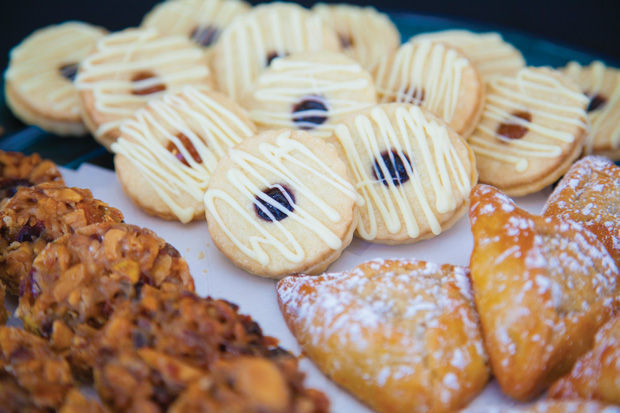Purim treats fit for a queen
Published February 25, 2015
Most of us are familiar with Purim, the holiday commemorating the story of the Jews of Persia, who avoided annihilation under the reign of King Ahasuerus. The story has a single villain, Haman, the mastermind of that sordid, ultimately failed plot. The heroine of the Book of Esther is the young and courageous queen who foiled the plot.
Yet, it is Haman’s hat, or rather the triangular shape of it, which Jews the world over have fashioned into that iconic Purim cookie known as hamentaschen. And with what special cookie do we recall our heroine? I couldn’t find one. Esther, I decided, needed her own Purim pastry.
When I described this dilemma to my husband and to my mother, I received nothing more from either of them than a blank stare. When I explained my quest to my daughter Kayla, who writes a food blog (minimalistpantry.com), I could sense her rolling her eyes as she said, “Mom, that is SO you.”
Nevertheless, I was determined to create a cookie or pastry that could remind us of the brave Queen Esther. I set out to design something attractive, sweet, delicious and easy to make. I have included two recipes below. Though seemingly lengthy, you will find the recipes easy to follow. To guarantee success, be sure to gather and measure your ingredients before beginning.
Chag sameach!
Margi Lenga Kahn is the mother of five and grandmother of five. A cooking instructor at the Kitchen Conservatory, she is working on a project preserving stories and recipes of heritage cooks. She welcomes comments and suggestions at [email protected].
Should you want to consider other “royal” desserts befitting of our heroic Queen Esther, here are two suggestions:
Braided Pastry
Make your standard yeasted challah dough. After the dough has risen overnight in the refrigerator, roll it out on your counter into a rectangle, approximately 14 by 10 inches, with a short end facing you. Lift rectangle onto a parchment-lined baking sheet.
Spread a 4-inch wide strip of pastry filling, perhaps poppy seed or almond (Solo brand has many varieties), down the length of the dough. With a pizza wheel, cut an equal number of angled strips on both sides of the filling from top to bottom of dough, from the outer edge to within a half-inch of the filling. Fold the strips over the filling, alternating one side and then the other, until all have been folded. Pinch and tuck the short ends of dough under the pastry and cover lightly with plastic wrap.
Let rise for 30 minutes at room temperature. Preheat oven to 350 degrees, brush top of dough with an egg wash and sprinkle with sugar. Bake for 30 minutes.
Royal Meringue Crowns
Beat 10 egg whites on high speed in a clean, dry bowl of an electric mixer until foamy. With mixer going, gradually add 1 cup of granulated sugar. Continue to beat until stiff peaks form when beaters are lifted. Remove bowl from mixer stand and gradually, using a wooden spoon or rubber spatula, fold in 1 cup of sifted powdered sugar. (You don’t want to deflate the meringue.)
Preheat oven to 225 degrees and line a baking sheet with parchment paper. Spoon meringue into a pastry bag fitted with a large star tip; pipe it into 2½- to 3-inch circles on the parchment paper-lined pan, one inch apart. Pipe another circle on top of the outer edge of the first one, creating a shallow cup.
Bake meringue cups for two to 2½ hours, or until they feel hard to the touch. Transfer meringue cups from pan to a cooling rack until completely cooled. Once cooled, they can be filled with custard, pudding or whipped cream, and topped with assorted fresh berries. Royal, indeed! (The unfilled cups can also be frozen in a zip-lock freezer bag for up to three months.)















